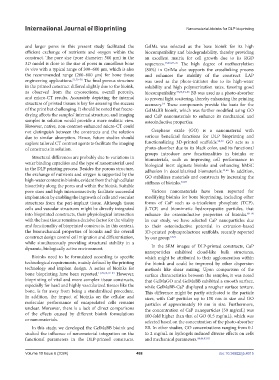Page 496 - IJB-10-6
P. 496
International Journal of Bioprinting Nanomaterial-bioinks for DLP bioprinting
and larger pores in this present study facilitated the GelMa was selected as the base bioink for its high
efficient exchange of nutrients and oxygen within the biocompatibility and biodegradability, thereby providing
construct. The pore size (pore diameter: 500 µm) in the an excellent matrix for cell growth due to its RGD
3D model is close to the size of pores in cancellous bone sequences. 15,25,27–36 The high degree of methacrylation
in vivo with a typical range of 300–600 µm, which is also (80%) in GelMa also supports the crosslinking process
the recommended range (200–600 µm) for bone tissue and enhances the stability of the construct. LAP
engineering applications. 51,73–78 The final porous structure was used as the photo-initiator due to its high-water
in the printed construct differed slightly due to the bioink, solubility and high polymerization rates, favoring good
as observed from the cryosections, overall porosity, biocompatibility. 37,69,84–86 BB was used as a photo-absorber
and micro-CT results. Accurately depicting the internal to prevent light scattering, thereby enhancing the printing
structure of printed tissues is key for assessing the success accuracy. These components provide the basis for the
14
of the print but challenging. It should be noted that freeze- GelMaBB bioink, which was further modified using GO
drying affects the samples’ internal structure, and imaging and CaP nanomaterials to enhance its mechanical and
samples in solution would provide a more realistic view. osteoinductive properties.
However, native, non-contrast-enhanced micro-CT could
not distinguish between the constructs and the solution Graphene oxide (GO) is a nanomaterial with
due to similar absorption. Hence, future studies should various beneficial functions for DLP bioprinting and
explore tailored CT contrast agents to facilitate the imaging functionalizing 3D-printed scaffolds. 58,59 GO acts as a
of constructs in solution. photo-absorber due to its black color, and its functional
groups introduce new functionalities in bioinks or
Structural differences are probably due to variations in biomaterials, such as improving cell performance in
water binding capacities and the type of nanomaterial used biological inert alginate bioinks and enhancing hMSC
in the DLP printing process. Besides the porous structure, adhesion in decellularized biomaterials. 44,66 In addition,
the exchange of nutrients and oxygen is supported by the GO stabilizes materials and constructs by increasing the
high-water content in bioinks, evident from the high cellular stiffness of bioinks. 83,87
bioactivity along the pores and within the bioink. Suitable
pore sizes and high interconnectivity facilitate successful Various nanomaterials have been reported for
implantation by enabling the ingrowth of cells and vascular modifying bioinks for bone bioprinting, including other
structures from the peri-implant tissue. Although tissue forms of CaP such as α-tricalcium phosphate (TCP),
cells and vascular structures might be directly integrated β-TCP, and biomimetic hydroxyapatite particles, that
into bioprinted constructs, their physiological interaction enhance the osteoinductive properties of bioinks. 88–90
with the host tissue remains a decisive factor for the vitality In our study, we have selected CaP nanoparticles due
and functionality of bioprinted constructs. In this context, to their osteoinductive potential in extrusion-based
the biomechanical properties of bioinks and the overall 3D-printed polycaprolactone scaffolds, recently reported
construct design control cell migration and differentiation, by our group. 65,91
while simultaneously providing structural stability in a
dynamic, biologically active environment. In the SEM images of DLP-printed constructs, CaP
nanoparticles exhibited cloud-like bulk structures,
Bioinks need to be formulated according to specific which might be attributed to their agglomeration within
technological requirements, mainly defined by the printing the bioink and could be improved by other dispersion
technology and implant design. A series of bioinks for methods like shear mixing. Upon comparison of the
bone bioprinting have been reported. 11,29,50,79–83 However, surface characteristics between the samples, it was noted
bioprinting of vital and more complex tissue constructs, that GelMaGO and GelMaBB exhibited a smooth surface,
especially for hard and highly vascularized tissues like the while GelMaBB-CaP displayed a rougher surface texture.
bone, is far away from being a standardized procedure. This difference might be partly attributed to the particle
In addition, the impact of bioinks on the cellular and sizes, with CaP particles up to 150 nm in size and GO
molecular performance of encapsulated cells remains particles of approximately 10 nm in size. Furthermore,
unclear. Moreover, there is a lack of direct comparisons the concentration of CaP nanoparticles (50 mg/mL) was
of the effects caused by different bioink formulations 100-fold higher than that of GO (0.5 mg/mL), which was
or nanomaterials. selected based on the concentration of the photo-absorber
In this study, we developed the GelMaBB bioink and BB. In other studies, GO concentrations ranging from 0.1
studied the influence of nanomaterial integration on the to 2 mg/mL in hydrogels induced diverse effects on cells
functional parameters in the DLP-printed constructs. and mechanical parameters. 44,46,83,92
Volume 10 Issue 6 (2024) 488 doi: 10.36922/ijb.4015

